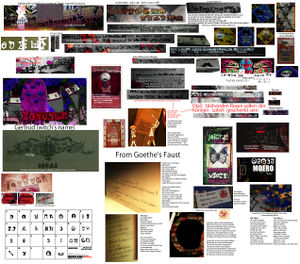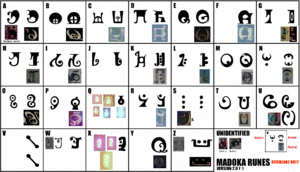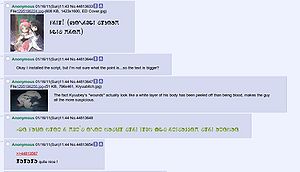Deciphering the runes: Difference between revisions
Homerun-chan (talk | contribs) m (→History: rewording it a bit) |
|||
| Line 11: | Line 11: | ||
After some urging to use the Faust quotes as a [[wikipedia:Rosetta Stone|Rosetta Stone]], an anonymous found and [http://green-oval.net/cgi-board.pl/a/thread/44782290#p44786690 posted] a line of runes which matched one of those quotes. The runes and the German sign they matched are marked in red on the translation chart for episodes one and two. | After some urging to use the Faust quotes as a [[wikipedia:Rosetta Stone|Rosetta Stone]], an anonymous found and [http://green-oval.net/cgi-board.pl/a/thread/44782290#p44786690 posted] a line of runes which matched one of those quotes. The runes and the German sign they matched are marked in red on the translation chart for episodes one and two. | ||
This discovery confirmed that the runic script was a direct substitution for German letters and provided an initial set of translated runes to work with. /a/ quickly got to work using this starting set to translate more lines and fill in the gaps. Within 21 hours of this discovery, the vast majority of runic text appearing in the first two episodes had been translated into German and English, all letters had been identified (except Q and X which are extremely rare in German though | This discovery confirmed that the runic script was a direct substitution for German letters and provided an initial set of translated runes to work with. /a/ quickly got to work using this starting set to translate more lines and fill in the gaps. Within 21 hours of this discovery, the vast majority of runic text appearing in the first two episodes had been translated into German and English, all letters had been identified (except Q and X which are extremely rare in German, though they appeared later on). | ||
==Complications== | ==Complications== | ||
Revision as of 09:52, 14 April 2011
The runes that randomly appear in the Magic World have nearly been solved. This page is meant to show the current works and discoveries in the domain, as well as the latest discussions and hypothesis.
History
Initial efforts at codebreaking began by identifying each unique rune and assigning it a random letter for identification. The general (correct) assumption was that each rune corresponded to a letter in German but at the time it was still possible that the text was encrypted, a newly constructed language or even that they were just scattered completely at random. German was chosen as the most likely candidate because it appeared as direct quotes from Goethe's Faust and the Cottonballs/Pringlemen/Anthony's were observed to be chanting in German. Other candidate languages were; Japanese, English and Latin (due to the use of "Puella" in the title).
A number of codebreaking methods were tried unsuccessfully. For example; attempts at identifying the letters through numerical analysis of their frequency failed, implying that the runic script was not really a language (see complications below). A more focused approach, taking a single word or short phrase and attempting to match an appropriate German word to it also failed due to large amount of possible matches.
After some urging to use the Faust quotes as a Rosetta Stone, an anonymous found and posted a line of runes which matched one of those quotes. The runes and the German sign they matched are marked in red on the translation chart for episodes one and two.
This discovery confirmed that the runic script was a direct substitution for German letters and provided an initial set of translated runes to work with. /a/ quickly got to work using this starting set to translate more lines and fill in the gaps. Within 21 hours of this discovery, the vast majority of runic text appearing in the first two episodes had been translated into German and English, all letters had been identified (except Q and X which are extremely rare in German, though they appeared later on).
Complications
Throughout the translation process, efforts were hampered by several complications:
- Runic fonts
- There are at least three structurally distinct variants of the runic script. The two most common variants are known as modern and archaic. Corresponding letters are generally quite similar with only mild variation in their overall structure but a few letters, such as T, are completely different from each other. The third and least common variant is constructed from elements found in musical scores, and many of the runes are unrecognizable.
- Typos
- Whether by mistake or on purpose (to frustrate codebreakers) approximately half of the lines of script contain one or more typos or misspelt words.
- Spacing
- Many lines of script have no spacing between the words or may be seperated in a deceptive manner. Also, some lines have multiple adjacent letters overlaid on the same space.
Table of runes
Translated runes by appearance
- The episodes
- Other sources
Extras
Runic Font
A custom font had been created using the Runic characters and a Greasemonkey script allowed 4channers to communicate on the board in Runespeak.
- Download TTF font (Last Update: 02-17-2011)
- Single Letters (SVG)
- Greasemonkey script (replace spoilers by Runespeak)
- Greasemonkey script (replace spoilers and [madoka] tags -- please refrain from using [madoka] tags though)
- Online Converter (just type and get runic text immediately)
- Madoka Rune Converter (type and get runic text)
- MADOKA RUNE TRANSLATION (type runic characters and get normal text)
Musical runes font
A very rough font made from already vectorized musical runes.
MediaFire links:
Using runes on this wiki
You can also use runes on this wiki with the {{Runes}} template, e.g. {{Runes|DENY THE OBVIOUS, UPHOLD THE INANE}} becomes DENY THE OBVIOUS, UPHOLD THE INANE (use uppercase for archaic variant and lowercase for modern variant).
To use musical runes, add |variant=musical to the template, eg. {{Runes|OKTAVIA VON SECKENDORFF|variant=musical}} becomes OKTAVIA VON SECKENDORFF. The font does not distinguish uppercase and lowercase letters, so either will produce the same results.
Special Characters
Aside from the basic alphabet, runic numerals 0, 1, 2 and 3 are included in the font, as well as a number of special characters which can be viewed using ?, ~, ®, @ and #.
Using Greasemonkey scripts
- Download and install the Greasemonkey add-on:
- Greasemonkey add-on for Firefox
- NinjaKit extension for Safari
- Chrome natively supports userscripts
- Download and install the MadokaRunes font
- Install the script
- Restart your browser if necessary
- Spoilers and/or [madoka] tags will now be displayed in runic script









































































